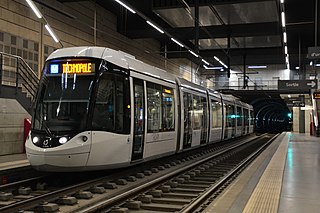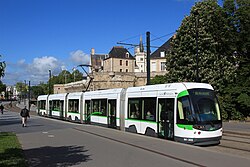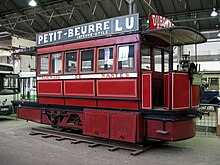
The Sydney light rail network is a light rail/tram system serving the city of Sydney, New South Wales, Australia. The network currently consists of three passenger routes, the L1 Dulwich Hill, L2 Randwick and L3 Kingsford lines. The network comprises 42 stops and a system length of 24.7 km (15.3 mi), making it the second largest light rail network in Australia behind the tram network in Melbourne, Victoria. A fourth line, the 12 km (7.5 mi) L4 in Sydney's west, is planned to open in late 2024.
There have been two separate generations of trams in London, from 1860 to 1952 and from 2000 to the present. There were no trams at all in London between 1952 and 2000.

The Grenoble tramway is the tram system in the city of Grenoble in the Rhône-Alpes region of France. In 1987, Grenoble became the second French city to reintroduce trams, the first being the Nantes tramway. The current network is 35-kilometre (22 mi) long, and comprises five lines: lines A, B, C, D and E. Line A was opened in 1987, line B in 1990, line C on 20 May 2006, line D in October 2007 and line E on 28 June 2014.

Trams in Nice was the first-generation tramway system serving the city of Nice, France, which operated from 27 February 1879 to 10 January 1953.

The Rouen tramway is a tramway / light rail network in the city of Rouen, Normandy, France. Construction began in 1991 and the network opened for service on 17 December 1994.

The Tramway Français Standard (TFS) is a type of tram designed and manufactured by Alstom for use on various tramway systems in France. The TFS is no longer in production, having been superseded by the Alstom Citadis range of tramcars.

Daugavpils Satiksme is the public transport corporation which operates tram and bus systems in the eastern Latvian city of Daugavpils.

The Tramway de Versailles or Tramway Versaillais was a 1,435 mm standard gauge tramway system serving the French city of Versailles.

The Marseille tramway is a tramway system in Marseille, France. The city's modern tram network now consists of three lines, serving 32 stations and operating over 15.8 kilometres (9.8 mi) of route. The current, modern Marseille tram network opened on 7 July 2007.

The Saint-Étienne tramway is a tram system in the city of Saint-Étienne in the Rhône-Alpes (France) that has functioned continuously since its opening in 1881. The first tramway line was steam-operated and was opened by the Chemins de Fer à Voie étroite de Saint-Étienne (CFVE) on 4 December 1881, stretching for 5.5 km between La Terrasse and Bellevue. The CFVE took over the Compagnie des Tramways Électriques de Saint-Étienne lines and discontinued the use of steam in 1912.

The Mekarski system was a compressed-air propulsion system for trams invented by Louis Mékarski or Louis Mékarsky in the 1870s. He worked in France, was born in 1843 in Clermont-Ferrand of Polish origin. Many references to him use the Polish name Ludwik Mękarski.

The earliest trams in Australia operated in the latter decades of the 19th century, hauled by horses or "steam tram motors". At the turn of the 20th century, propulsion almost universally turned to electrification, although cable trams lingered in Melbourne. In cities and towns that had trams, they were a major part of public transport assets.

Semitan is the company responsible for the comprehensive public transport network of Nantes Métropole, the urban community of the French city of Nantes. The network operated by Semitan is marketed under the name and logo TAN and this abbreviated form is also sometimes used to refer to the company. Semitan is itself an acronym for the Société d'Economie Mixte des Transports de l'Agglomération Nantaise. The TAN network comprises three Tramway lines, two Busway lines, an extensive network of buses, an airport shuttle bus line, two Navibus lines and a night bus network. A single common fare system covers all these modes and also extends to suburban trains within the Métropole boundaries, although these trains are not operated by Semitan.

The Nantes Busways are bus rapid transit lines operating in the city of Nantes, France. The service was inaugurated on November 6, 2006, and is operated by Semitan. The line 4 runs from Place Foch to Porte de Vertou on a dedicated right-of-way, and interconnects with line 1 of the Nantes Tramway at Duchesse Anne Château station. Four park & ride facilities have been built along the construction of the line to encourage passengers to use public transport. Nantes Busway line 4 is NF certified. A victim of its own success, Busway line 4 attracts higher ridership than Semitan expected, pushing the system to saturation. Buses are overcrowded at peak times and nearly full off-peak. Semitan tested the Hess LighTram in November 2009 to eventually increase capacity of the system and relieve overcrowding at peak times. Though that solution wasn't implemented at that time, Semitan decided to increase passage frequencies to less than 3 minutes at peak times. If saturation recurs, Busway line 4 might be converted into a Tramway line in the future.

Navibus is a group of water bus routes in the French city of Nantes, operated as part of the Tan urban transit network that also includes buses and trams. Routes operate on both the River Loire and the River Erdre, and accept the full range of standard Tan tickets.

Trams in France date from 1837 when a 15 km steam tram line connected Montrond-les-Bains and Montbrison in the Loire. With the development of electric trams at the end of the 19th century, networks proliferated in French cities over a period of 15 years. Although nearly all of the country's tram systems were replaced by bus services in the 1930s or shortly after the Second World War, France is now in the forefront of the revival of tramways and light rail systems around the globe. Only tram lines in Lille and Saint-Étienne have operated continuously since the 19th century; the Marseille tramway system ran continuously until 2004 and only closed then for 3 years for extensive refurbishment into a modern tram network. Since the opening of the Nantes tramway in 1985, more than twenty towns and cities across France have built new tram lines. As of 2024, there are 28 operational tram networks in France, with 3 more planned. France is also home to Alstom, a leading tram manufacturer.

The Casablanca Tramway is a low-floor tram system in Casablanca, Morocco. As of 2024, it consists of four lines - T1 from Sidi Moumen to Lissasfa, T2 from Sidi Bernoussi to Aïn Diab, T3 from Casa Port Station to Hay El Wahda, and T4 from Arab League Park to Mohammed Erradi—which intersect at nine points

The Bern tramway network is a network of tramways forming part of the public transport system in Bern, the capital city of Switzerland. In operation since 1890, it presently has five lines, one of which incorporates the Bern–Worb Dorf railway.

The Tram System of Tallinn is the only tram system in Estonia. Together with the four-route trolleybus network (et), the four tram lines, with a total length of 19.7 km, are arranged in a roughly cross-shaped layout, providing a backbone for the public transport network in the Estonian capital. Four of the five routes meet up at the stop Hobujaama, in the city center. Trams are unidirectional, one-sided and single-person operated, and much of the network runs on segregated two-way track.

The Besançon Tram network dated back to a horse tram service inaugurated in 1887. The first two electric tram lines began operating in 1897, joined later by more. However, the system, which used only single tracks for its two lines, was badly damaged during World War II from which its finances also emerged in a parlous condition. In 1952, the operation having run out of funding possibilities, the Besançon trams were withdrawn: a city bus service was inaugurated in December 1952.






























